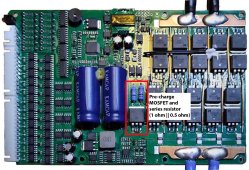Does anyone use a Seplos BMS 200A Lifepo 16s with a Multiplus II 48/5000 and has experience with precharge after BMS disconnects?
If you are offgrid and BMS disconnects battery for any reason, inverter is shutdown, inverter capacitors are drained.
If BMS connects battery again (after error condition has gone), seplos BMS will activate precharge first, than - after configured precharge time - activate discharge MOSfets.
Seplos manual contains no details about precharge current or maximum capacity of inverter caps that can be charged. If caps are not charged up enough, inrush current could still exceed current limits, BMS may disconnect battery for safety.
Has anyone successfully used Seplos precharge with Multiplus?
If you are offgrid and BMS disconnects battery for any reason, inverter is shutdown, inverter capacitors are drained.
If BMS connects battery again (after error condition has gone), seplos BMS will activate precharge first, than - after configured precharge time - activate discharge MOSfets.
Seplos manual contains no details about precharge current or maximum capacity of inverter caps that can be charged. If caps are not charged up enough, inrush current could still exceed current limits, BMS may disconnect battery for safety.
Has anyone successfully used Seplos precharge with Multiplus?
Last edited:



